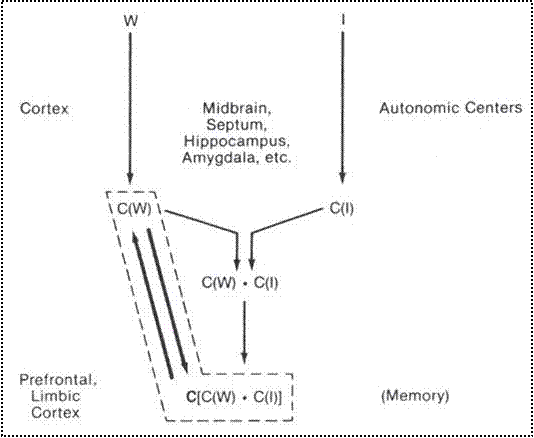

|
Scientific Understanding of Consciousness |

|
This arcane diagram by Edelman is his attempt to help convey the idea of primary (core) consciousness. Two sources of information, W and I, enter the cortex and are acted upon in a way that gives rise to the emergent property of consciousness. The central focus of the consciousness functionality is the operation in the dashed area, which comprises a widely dispersed, sparse, dynamic network of neuronal assemblies, ever changing on the basis of a few milliseconds. Population statistics of dendritic tree synapses determine which synapses are active at each moment. The dotted outer box encompasses the cortex together with limbic system and some other midbrain areas. The information elements symbolized in the diagram can be discussed as follows:
The symbol I refers to what Edelman calls the interoceptive input, i.e. the pattern of neural activity representing the self. This pattern of neural connectivity has been established over a lifetime and represents genetics and experience in the ensemble of synaptic strengths that have been facilitated over the lifetime of the individual. This pattern of facilitated synaptic strengths, continuously active via the thalamocortical signal flows, represents the self of the individual.
The symbol W refers to what Edelman calls the exteroceptive or world input, i.e. the pattern of neural activity representing the current mental image of consciousness. This pattern of neural connectivity is established on a millisecond by millisecond basis in response to sensory input and/or by declarative memory reconstruction.
The expression C(W) ● C(I) represents the neural basis of interactions and comparison of the incoming image information with long-term information stored in memory. This operation is the fundamental basis of Edelman’s “remembered present”. The I information, the long-term memory stored in the pattern of synaptic strengths representing the self, is the “remembered” part of remembered present. The W information expressed in the pattern of synaptic strengths representing a current mental image is the “present” part of remembered present.
The information represented by W and I is not handled and processed in distinct and separate areas of the brain. The information representing the self consists of the entire ensemble of synaptic strengths in the brain. These synaptic strengths include all memory, explicit and implicit. A momentary perception consists of a pattern of activity superimposed upon the synaptic strengths of the self. The short-term resilience of synaptic strengths comprise short-term memory. The neural activity pattern of the self and a perception comprises the dynamic core and includes activity of working memory, other prefrontal functionality, the hippocampus, and subcortical areas including the limbic system. The neurons and neuron assemblies comprising the dynamic core change on a moment-to-moment basis. Perception stimulates the associative characteristic of memory to generate time sequencing and spatial expansion of gestalts.
The expression C[C(W) ● C(I)] represents a conceptual recategorization of the C(W) ● C(I) . This is a recondite concept; I’ll say a few words to try to help clarify it. This operations takes place on an ongoing recursive basis of about 10 to 100 ms. The mental image represented by the neural patterns symbolized by W is ever changing and is compared with the long-term memories symbolized by I, representing the self. This instant-by-instant perceptual categorization results in mental images of objects or ideas associated with consciousness. The W information can be the result of sensory input or long-term memory reconstruction.
Recursive functionality operates on the C[C(W) ● C(I)] expression to update it on the basis of about 100 ms. This is indicated in the dashed box area which shows the ever changing sensory input data C(W). Consciousness arises as a result of this recursive functionality via the thalamocortical system.
Consciousness arises as a result of reentrant, currently-active connectivity and signaling between C[C(W) t=n • C(I)t=n] and C(W)t=n+1; this is outlined in the dashed box. This recursive functionality takes place in thalamocortical pathways and in ever descending recursive hierarchies to local recursive pathways in neuronal assemblies. Damasio’s Convergence-Divergence Zones implements this recursion. Fuster’s perception-action cycle is a different perspective on this recursion. . (Fuster, Prefrontal Cortex, 382) This neural network recursive functionality takes place on the basis of about 10 to 100 ms. |
|
Edelman’s Primary (Core) Consciousness Diagram (Edelman, Remembered Present, 156) |
|
The procedure recursively implements a Bayesian Inference where:
C(W) t=n is the a priori estimate, and C(W)t=n+1 is the a posteriori estimate |
Return to — Perception, Memory, ConsciousnessLink to — Consciousness Subject OutlineFurther discussion — Covington Theory of Consciousness |